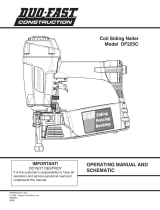
20
PELIGRO
La falta de observación de cualquiera de estas instrucciones puede ser causa de graves
lesiones personales, tanto al operador de la herramienta comoa quienes estén cerca de
ella o de daños materiales o a la herramienta.
LA SEGURIDAD ESTA PRIMERO
Estas instrucciones proporcionan la información necesatia para el
funcionamiento sin peligrode las herramientas Paslode .
NO trate
de usar su herramienta hasta que no haya léido y entendido
todas las precauciones de seguridad y las instrucciones de
este manual.
PROTEJASE LOS OJOS Y LOS OIDOS
Use siempre el equipo adecuado para protegerse los ojos y los
oídos que sea conforme con ANSI Z87, meintras usa una her-
ramienta o trabaja cerca de una herramienta en uso. Como em-
pleador usted es responsable de imponer el usp del la porteccion
de ojo. Lleve sombreros duros en los ambientes que requieren
su uso.
USE SU HERRAMIENTA SOLAMENTE PARA EL
PROPOSITO CON QUE FUE DISEÑADA
No arroje la herramienta al suelo; no golpee el armazón ni la use
como un martillo.
NUNCA USE LA HERRAMIENTA PARA JUGUETEAR
Esta herramienta no es un juguete; por lo tanto no la trate como
tal. Nunca juguetee con ella, ni se apunte a usted mismo ni a otra
persona, aun cuando crea que no está cargada.
NUNCA ASUMAQUE LA HERRAMIENTA ESTA VACIA
Verfique que ho haya sujetadores en elcargador. Aun cuando crea
que está vacía o desconectada, nunca se apunte ni apunte a otra
persona con la herramienta, porque podría dispararse un sujetador
que no esté a la vista.
NUNCA SUJETE EL GATILLO EN LA POSICION DE
CIERRE O DE FUNCIONAMIENTO
Nunca se debe manipular indebidamente o dejar inoperante el
gatillo, o sujetarlo en la posición de cierre o defuncionamiento,
porque se podría disparar un sujetador al oprimirse el elemento
de contacto.
NO CARGUE SUJETADORES CUANDO LA LINEA DE
AIRE COMPRIMIDO ESTE CONECTADA, O CUANDO
EL GATILLO O EL ELEMENTO DE CONTACTO ESTE
OPRIMIDO.
Antes de cargar sujetadores en la herramienta, verifique que la
línea de aire comprimido esté desconectada y que ni el gatillo ni
el elemento de contacto estén oprimidos.
USE LA HERRAMIENTA SOLAMENTE SOBRE UN MA-
TERIAL DE TRABAJO
La herramienta debe funcionar sólo cuando esté en contacto con el
material de trabajo. Debe tener mucho cuidado cuando el material
sea delagado o trabaje cerca de las aristas del mismo, porque los
sujetadores podrían atravesar o salirse del material.
NO DEJE INOPERANTE NI QUITE EL ELEMENTO DE
CONTACTO
Esta herramienta está equipada con un mecanismo de seguridad,
llamado elemento de contacto, para prevenir cualquier disparo
accidental. Nunca manipule indebidamente, deje inoperante, ni
quite el elemento de contacto. No use la herramienta a menos que
dicho elemento funcione correctamente, porque podría producirse
un disparo imprevisto.
DESCONECTE LA HERRAMIENTA CUANDO NO LA
ESTE USANDO
Siempre desconecte la herramienta de la línea de aire comprimdo
cuando no la esté usando o al dejar su lugar de trabajo. Nunca la
descuide, porque cualquier persona que no esté familiarizada con
ella podría lastimarse o lastimar otros.
TOME LA HERRAMIENTA SOLAMENTE POR EL
MANGO
Siempre tome la herramienta sólo por el mango. Nunca la tome
por la manguera o con el gatillo oprimido, porque se podría
disparar un sujetador y herirlo o herir a otra persona.
NO ALTERE EL ARMAZON DE LA HERRAMIENTA
El armazón de la herramienta es un recipiente a presión y nunca se
debe grabar en su superficie el nombre de su compañia, el del área
de trabajo, ni ningún otro detalle.
DESCONECTE LA HERRAMIENTA PARA HACER
REPARACIONES O ELIMINAR OBSTRUCCIONES
Nunca trate de eliminar obstrucciones o reparar una herramienta
sin haberla desconectado de la línea de aire compromido y quitado
todos los sujetadores.
USE SIEMPRE LOS ADAPTADORES APROPIADOS
PARA SU HERRAMIENTA
Se debe conectar a la herramienta solamente conectores neumáticos
MACHOS, para permitir que el aire de alta presíon salga tan pronto
como se desconecte la línea de aire comprimido.
NUNCA coloque enlaces HEMBRAS de desconexíon rápida en la
herramienta, porque atrapan el aire a alta presíon al desconectar
la línea de aire comprimido, dejándola cargada y lista para disparar
por lo menos un sujetador.
NO EXCEDA LA PRESION NEUMATICA MAXIMA
RECOMENDADA
La herramienta debe funcionar sólo con la presíon neumática
recomendada. No exceda la presíon neumática máxima marcada
en la herramienta. Verifique por lo menos dos veces al día que el
calibre de la presíon neumática funcione correctamente.
Nuna use aire o gases envasado, como el oxígeno, para hacer
inflamables, gases o polvo combustible.
INSPECCIONE LA HERRAMIENTA PARA LA
OPERACION APROPIADA
Limpie diariamente la herramienta y lubríquela como se recom-
ienda. Nunca trate de hacer funcionar una herramienta sucia o
defectuosa.
USE SOLAMENTE PIEZAS Y SUJETADORES
RECOMENDADOS POR PASLODE
Use sólo piezas y sujetadores específicamente diseñados y
recomendados por Paslode para usar con esa herramienta y para
la tarea requerida. Si se usan piezas o sujetadores no autorizados
o se modifica de alguna forma la herramienta, se pueden crear
situaciones peligrosas. Vuelva a colocar todas las etiquetas de
precaucíon que flaten. Consulte el diagrama de la herramienta sobre
el número de cada parte y su ubligación correcta.
®
opere en atmósferas explosivas como en presencia de líquidos
funcionar la herramienta porque podrían hacer que explotara. No
INSTRUCCIONES DE SEGURIDAD
4
®
®




















